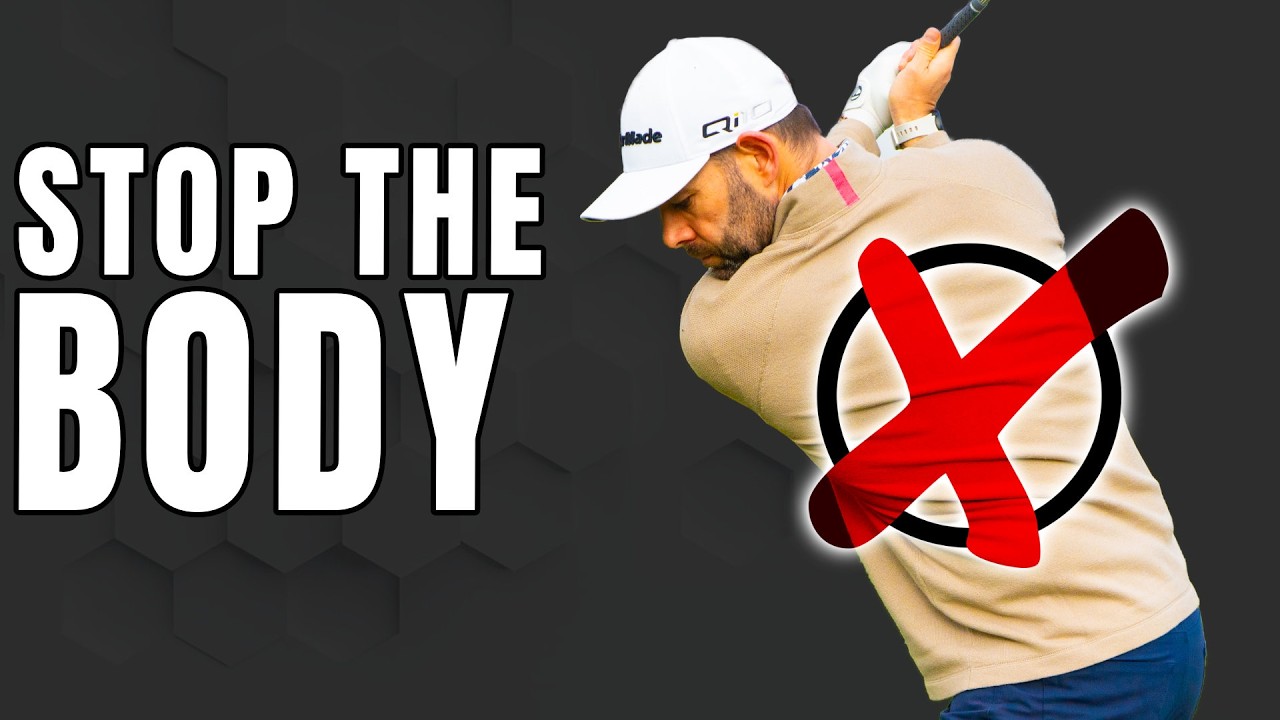Most golfers are told to “turn through the ball” aggressively to generate power — but that advice could be ruining your driver swing.
In this video, I reveal a move that seems strange at first… but it’s exactly what top players do. Using real swing data, we’ll look at how slowing down the hips and torso before impact helps release the club with maximum speed and precision — a sequence that catapults the club through the ball.
You’ll learn:
Why turning hard can actually reduce clubhead speed
How proper sequencing builds effortless power
What the pros do differently that most golfers never notice
The feel that produces speed without swinging harder
This one shift could totally change how you use your body with the driver. Give it a watch — and don’t be surprised if it feels weird at first!
📲 The Chris Ryan Golf Academy App
The all-in-one coaching platform designed to help you train smarter, practice better, and play your best golf! 🎯
✅ Structured training plans
✅ Fun & effective practice games
✅ Exclusive content not on YouTube
Start your 7-day free trial today! ⬇️
🔗 https://www.chrisryangolf.com/chris-ryan-golf-academy-app/
⛳ Want to Play Better Golf?
Join me on the journey to lower scores and more enjoyment on the course! Don’t forget to LIKE, COMMENT & SUBSCRIBE for weekly golf coaching videos.
💬 Got a question? Drop a comment below – I read them all!
📩 Want to work with me? Email: chris@chrisryangolf.com
🌍 Visit My Website: www.chrisryangolf.com
🎥 Want Personal Online Coaching?
If you’re serious about improving, I offer personalised online coaching to help you reach your goals faster.
🔗 https://www.chrisryangolf.com/online-coaching/
🤝 My Trusted Partners
🔥 TaylorMade Golf – https://www.taylormadegolf.eu
🏌️♂️ Clubhouse Golf – https://www.clubhousegolf.co.uk
🎯 Hack Motion – https://www.hackmotion.com/chrisryan
📡 FullSwing – https://www.fullswinggolf.com
🎯 PuttOut Golf – https://www.puttout.golf
👟 Adidas Golf
🔧 Mapei – https://www.mapei.com/GB-EN/
00:00 Introduction
00:26 Don’t Turn Through The Golf Ball
00:52 Perfect Sequencing
02:52 Driver Release Drill
05:50 How To Break Through Impact
You have probably been told to rotate hard through the golf ball. I’m going to tell you and prove to you why doing the complete opposite is actually going to be beneficial for your driving. And I’ve got some proof and some data to back that up. So, let’s me hit a drive. We got the full swing kit down here. I’m just going to try and turn through this as aggressively as I can with my body. Really trying to get through the golf ball. And we will see what happens. Oh well, I’m not even sure whether the full swing is going to pick up that ball play because it went straight into that tree. Uh, so pretty awful. So for me, that club head speed was significantly down and the face was way open, which is why it went straight into that tree. So that is likely going to happen when you try and turn your body through the golf ball aggressively. You’re going to have reduced speed and you’re likely to leave the face open. Let’s do a little demonstration. I’m going to take my towel. I’m going to kind of wrap it around my hand. And if I was going to try and crack this towel or whip, let’s say, the the two iron in there, it doesn’t really matter how fast I move my hand towards my golf bag. I can’t really crack that whip. I can’t get any speed into the end of the towel. What’s actually more important, and obviously we’ll relate this back to the golf swing in a moment, is yes, I’ve got to have some speed in my hand, but it’s how quickly I can slow my hand down, how quickly I can decelerate my hand. Because when I do that efficiently, the speed gets transferred to the end of the towel. So, just look at the difference. There’s nothing in the end of the towel at all. And as soon as I decelerate, big difference. big difference in what’s happening with the end of the towel. I’m basically able to transfer the energy from my hand through to the end of the towel far more efficiently. Now, let’s look at a graph. This is called the kinematic sequence. This is showing the rotation of my hips, my torso, my arms, and my club and how they’re moving through the golf swing. And what you’ll see is before impact hips and torso significantly slowing down. That graph is going steeply down. So what we know is in the golf swing there should be rotational speed in the body but before impact those things should slow down significantly. When that happens it allows speed to get into the golf club. We all want that. And as we get speed into the golf club and we release it, the face is able to square up naturally or more naturally. When we use rotation all the way through, we get something like this. No speed in the club. Face is way open. Let’s bring in this. This is an impact bag. Now, I appreciate you might not have one of these, but you can use side of your golf bag. You can use a cushion that you got at home. get a little creative. I’m going to turn the golf club around. I’m going to hold the driver head right by the the club shaft. Got a little fly on my wrist. And what I’m going to do is I’m going to take my normal setup with the grip of the golf club into the end of the bag. Then what I’m going to do is I’m going to take a step back by just over a foot. What I’m now going to do is I’m going to bring my feet a little bit closer. I’m going to make a pretty normal back swing. I’ve got rotation through my hips. I’ve got rotation through my torso. As I start my down swing, what I’m going to do is I’m going to step forwards towards the golf bag, which now means I can obviously reach the golf bag. Now, what’s going to happen is my body is rotating away from the target. When I step forwards, I’m going to make my rotation towards the fairway. So, I’m going to rotate forwards. But because my lead foot is in front of my trail foot, it’s basically going to stop me rotating much further than this. It’s kind of blocking off my rotation. So, what I’m able to do is I’m able to rotate hard but break. This lead foot moving forwards is effectively my braking mechanism. And what that will then do is it will cause the torso to break. It will then cause the arms to accelerate and the club to accelerate. And what you should start to get is something that looks a bit like this. Makes a good noise out, doesn’t it? Notice how square on my body is. Now, that’s a little bit extreme. We normally would have the body a little open, bearing in mind this is a drill. But what it’s teaching you is it’s teaching you the sequence that we want. Yes, of course. From here, we want some body rotation. But if that never slows down, the speed never ends up into the grip of the club. In this case, we have to rotate and we have to break. And when we can rotate and break, the speed gets into the golf club. And to me, that feels really natural. You see, I’m doing it with one hand because it’s sequencing. I can hold that club in just three fingers. I don’t really feel like I’ve got a lot of control over it. But if my sequencing is good, then I’m able to really get the speed out into the golf club. That’s what great players do because they appreciate that good sequencing gives them good speed, but it also helps the club square up. So once we then take the golf bag out the way, I mean, the first part to all of this is really just to, you know, never hit drives where you’re trying to rotate as aggressive as you can through the golf ball because that’s not what we see the best players in the world do. So how do we then take that into a into a full swing? Well, what is the breaking mechanism when you’re actually hitting a golf shot? Because obviously we’re not stepping sort of forwards. Well, in the golf swing, the braking mechanism is when you push from the ground. So, we know that with drivers, but also all the clubs in the bag, as we begin down, we move pressure into our lead side. So, my lead hip stays low. We move our pressure and we apply force under that lead side. As we’re doing that, we are rotating. But if I continue to rotate, then we never really get that braking mechanism. What great golfers do is they apply pressure into that lead side. There is pressure to that lead foot and what they will then do is they will start to push up from the ground. That push raises the lead hip, straightens the leg, and starts to slow down the rotation through the hips and through the torso. That movement then allows the club to release. So, the next little exercise to take from that impact bag drill is one where we push off and back with the driver. So, I’m going to do this inside the ball. So, here’s what I’m going to do. I’m going to make a back swing. I’m going to apply pressure. And when I want to release the club, I’m going to push up and off that back foot. And what I’m really doing is I’m applying the brakes. And whilst this looks pretty strange, what you’ll start to feel is that as you start to push up and off the ground with that lead foot, the club naturally wants to increase in speed and release. It becomes almost impossible to hold on. It becomes almost impossible to deliver the face open with hands forward because I can only do that when I’ve got rotation. When I’m starting to make these movements and push off that lead foot, that’s applying the brakes. That’s so key. We’ve explained why. It’s that sequence. It’s that that allows you to get the speed out into the club head. So, when you watch great drivers of the golf ball, what do you see them doing through impact? Do you see them turning or do you see them pushing up away from the ground? Well, it’s the latter. And I’ll put some on the screen here so you can see. That push is so key. So, what I’m going to do now is hit a shot where I really focus on that push and we should see the speed increase. With any luck, the face get a little closer to where it needs to be. And that is a much better drive.








50 Comments
A brilliant British pro Henry Cotton taught this by hitting a rubber tire, it taught hand strength at impact, the brake and he could hit it long and accurately from a three quarter swing. Chris, I’m glad you’re out there in the wilderness with just a few that teaches this. Ty sir
Watched this last week and shot my lowest round of the year at the weekend 79 🎉 stopped me pushing driver and added distance.
Isn’t a matter of the lead femur internally rotating before it then begins to externally rotate?
So Hogan in 5 lessons shows his driver stance which is closed. It this helping the breaking?
I wonder if the same result couldn't be achieved by staying behind the ball?
Great video. Can you make one for iron please? I used a similar technique for iron but I often hit the ground before the ball. Thanks
Two turns and a hit..
Don't forget the hit👍
I could not concentrate after you said 2 iron…😉.. Actually, this was a great video, as usual. 👍
Great job, thanks! Also enjoyed the interesting and respectful comments.
Same for irons?
this is an epiphany, amazing…it makes sense now
This is a brilliant exercise. There is way too much talk of rotation in the downswing and it ruined my game for years.
Yeah but this can be dangerous. I’ll quote Nick Faldo commentating on a broadcast one Sunday afternoon when a player hooked his shot in the fairway. Nick: “the body stops the arms keep going and left it goes”
basically just post up
of course pushing up the lead leg leads to topping
Great explination. That’s really hard to do
Thank you… just a great explanation of how to use the ground correctly.
I carried my impact bag with me every round this year. Completely changed my game. Five impact hits before every shot will lower your handicap so fast
(Larry San Diego) Long time subscriber and enjoy your detailed instruction and could this drill for the driver apply to irons. My assumption is yes!
WowowoW!
Really good lesson, well explained, straightforward in theory. Now for the practical application! Cheers.
Doesn't the slow down happen naturally when the hips reaches its physical range on the downswing?
Bryson Dechambeau, golf's "Mad Scientist" actually taught this push away step two years ago. Your bag drill is fantastic for visual, but give credit where credit is due. Bryson is the Man.
https://youtu.be/MrpXlouAJzE?si=WeTTU9PS7ZGpo7f0
It's so confusing though cause they say 'keep rotating, keep rotating' Driver drives me freaking nuts.
Now that's the best description and made super simple to understand……thank you Chris, that is locked into the premium golf file.
My last lesson, my pro told me I needed to brake my hips. Still working on it.
Great tips
The push up is applying the brakes in a car, the release is your phone and wallet rocketing off the seat into the footwell. Without the braking phone and wallet never move however fast you go.
1:35 I’m not seeing a deceleration as much as I’m seeing a wrist flick.
I love this video, BUT, I do see pros at impact with their shoulders behind the hips, not parallel to the target but only slightly ahead, and the hips are often at 45 degrees to the target. Your video suggests that the hips are fairly close to the line of the target. Can you clarify?
there's no hoodies in golf!!
I was SO excited when I saw this. I can't hit anything further than 150yds. This explained the driver in a way no one has been able to ever. The exercises felt AMAZING, I'm not slicing really much after implementing this, standard deviation over 100 shots is 27 yards, but my average with a driver over those same 100 shots is 122 yds. Which is pathetically ridiculous for an athletic male 6'3 and 185 lbs. Was really hoping this was the magic ticket that unlocked some power.
Then why not open your stance at address?
Consider cracking a rawhide whip, the hand stops to allow the tip to achieve supersonic speed.
Going to the range today to try this. Thank you.
Kinda like snapping the towel ,Chris !
Um the towel isn't snapping just due to you decelerating your hand, it's also the opposite direction yank towards your body properly the end of the towel forward. But literally everything else I liked. Lol
The brake !!!!! Best explanation of how they use ground for big power now i can put it to work because you explained it , thank you.
Does the same apply to irons?
Don’t fall for this commercial about a small fan that cools the room to 65 degrees in 5 minutes. It’s a scam.
Great video! I want to ask if you view the breaking as a feel/cue vs a real. I’ve heard that push up from the ground and lengthening of the torso called parametric acceleration and that some don’t consider it a breaking/stopping. They view it as the push up accelerates the club head and the rotation of the torso doesn’t slow but the club head rotates around the body much quicker so the torso to club speed slows down dramatically. Allowing the club head to square up as you describe. For me hearing things explained different ways is super helpful so I’m not trying to say one is right or one is wrong as long as the mental model is helpful, just want to clarify they’re both the exact same thing?
All correct, but so hard to do
This is the kind of crap you end up doing if you don’t know how to use your right arm.
Straight into the trees…you wished…you SLICED right into those trees.
You’ve just demonstrated what 2 time Masters champion Bubba Watson does. I used to think he had a reverse pivot but it’s clear he stops his forward motion in order to engage the quickness of the club head.
wouldn't this approach work with irons as well?
Doesn’t this promote a reverse pivot?
What about irons?
Yet ANOTHER video 8 minutes for something that can be explained in 2 minutes… enough already!!!
Great video as always. Chris does not know how to make a bad video.